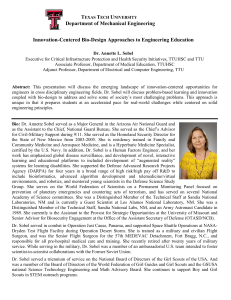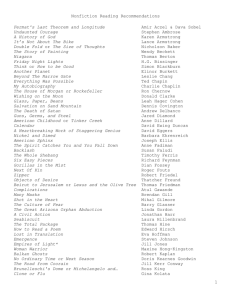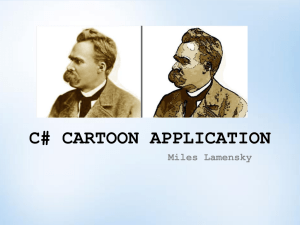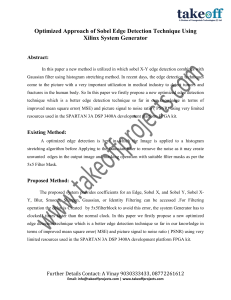Document 13136876
advertisement
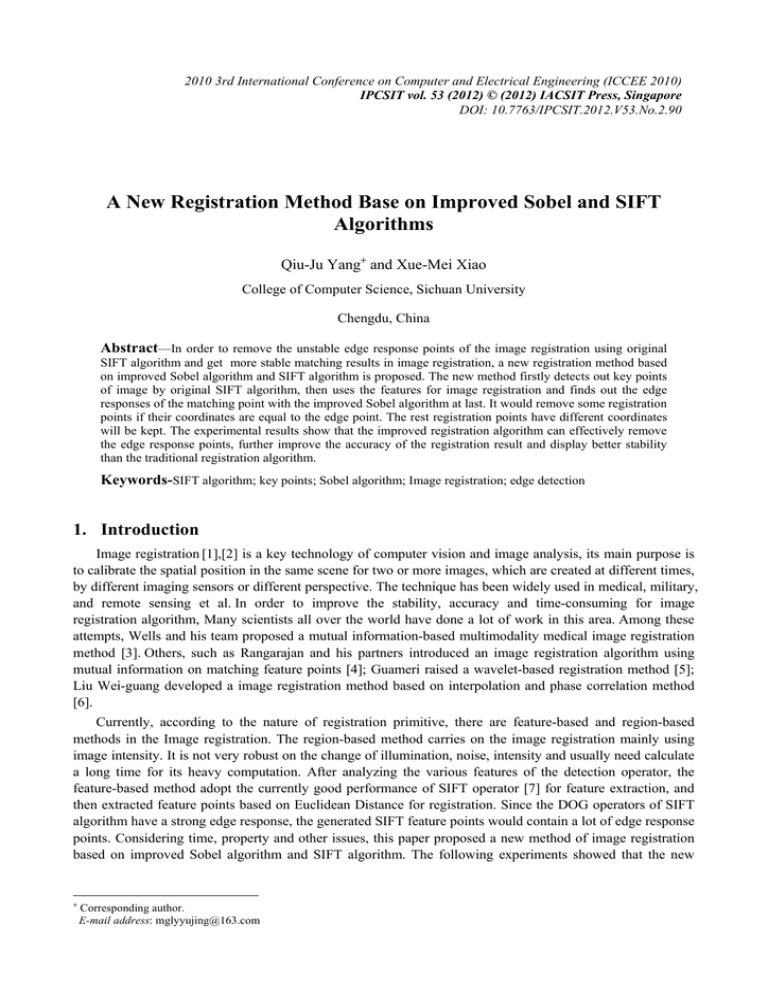
2010 3rd International Conference on Computer and Electrical Engineering (ICCEE 2010) IPCSIT vol. 53 (2012) © (2012) IACSIT Press, Singapore DOI: 10.7763/IPCSIT.2012.V53.No.2.90 A New Registration Method Base on Improved Sobel and SIFT Algorithms Qiu-Ju Yang+ and Xue-Mei Xiao College of Computer Science, Sichuan University Chengdu, China Abstract—In order to remove the unstable edge response points of the image registration using original SIFT algorithm and get more stable matching results in image registration, a new registration method based on improved Sobel algorithm and SIFT algorithm is proposed. The new method firstly detects out key points of image by original SIFT algorithm, then uses the features for image registration and finds out the edge responses of the matching point with the improved Sobel algorithm at last. It would remove some registration points if their coordinates are equal to the edge point. The rest registration points have different coordinates will be kept. The experimental results show that the improved registration algorithm can effectively remove the edge response points, further improve the accuracy of the registration result and display better stability than the traditional registration algorithm. Keywords-SIFT algorithm; key points; Sobel algorithm; Image registration; edge detection 1. Introduction Image registration [1],[2] is a key technology of computer vision and image analysis, its main purpose is to calibrate the spatial position in the same scene for two or more images, which are created at different times, by different imaging sensors or different perspective. The technique has been widely used in medical, military, and remote sensing et al. In order to improve the stability, accuracy and time-consuming for image registration algorithm, Many scientists all over the world have done a lot of work in this area. Among these attempts, Wells and his team proposed a mutual information-based multimodality medical image registration method [3]. Others, such as Rangarajan and his partners introduced an image registration algorithm using mutual information on matching feature points [4]; Guameri raised a wavelet-based registration method [5]; Liu Wei-guang developed a image registration method based on interpolation and phase correlation method [6]. Currently, according to the nature of registration primitive, there are feature-based and region-based methods in the Image registration. The region-based method carries on the image registration mainly using image intensity. It is not very robust on the change of illumination, noise, intensity and usually need calculate a long time for its heavy computation. After analyzing the various features of the detection operator, the feature-based method adopt the currently good performance of SIFT operator [7] for feature extraction, and then extracted feature points based on Euclidean Distance for registration. Since the DOG operators of SIFT algorithm have a strong edge response, the generated SIFT feature points would contain a lot of edge response points. Considering time, property and other issues, this paper proposed a new method of image registration based on improved Sobel algorithm and SIFT algorithm. The following experiments showed that the new + Corresponding author. E-mail address: mglyyujing@163.com algorithm could effectively remove the unstable edge response points and get the more stable results in image registration. 2. Sobel Edge Detection Algorithm 2.1. Traditional Sobel edge detection algorithm Sobel detection operator [8] is one of the best edge detection operators. For this operator, whether the pixel was in the image's edge is determined by the change of gray-scale transformation and directions in its neighborhood. Before demanding gradient, Sobel operator should get the weighted neighborhood average. The noise could be effectly suppressed after differentiation. The specific steps are showed as the following: • Calculate the horizontal gradient and vertical gradient for image. In the edge detection of classical Sobel operator, each operator is an approximation partial derivative, and the partial derivatives are calculated as (1) and (2). fx = [f (x + 1, y - 1) + 2f (x + 1, y) + f (x + 1, y + 1)] – [f (x - 1, y - 1) + 2f (x - 1, y) + f (x - 1, y + 1) (1) fy = [f (x - 1, y +1) + 2f (x, y + 1) + f (x + 1, y + 1)] – [f (x - 1, y - 1) + 2f (x, y - 1) + f (x + 1, y - 1) (2) • fx and fy could also be represented by convolution mask. As showed in the following, the element in the template represents weighted formula factor of corresponding pixel. fx: • 2.2. ⎛ −1 0 1 ⎞ ⎜ ⎟ ⎜ −2 0 2 ⎟ ⎜ −1 0 1 ⎟ ⎝ ⎠ ⎛ −1 −2 −1 ⎞ ⎜ ⎟ fy: ⎜ 0 0 0 ⎟ ⎜1 2 1⎟ ⎝ ⎠ Calculate the edge detection operator s(x, y) by selected hold value. If s(x, y) > Τ, the point will be considered as the edge point. (3) s( x, y ) = fx 2 + fy 2 Improved Sobel edge detection algorithm The calculation of traditional Sobel operator is relatively simple and fast. It could generate an ordinary edge and be smooth to noise, so Sobel operator exhibits good anti-noise ability and the detected edge has a nature of strong direction. But the traditional Sobel operator only adopt two directions of the template (such as fx, fy ) to detect image edges, the two templates can only detect horizontal and vertical image edge. So the Sobel operator is not isotropic, and the detected edges are not completely connected. These fractures will terribly reduce the accuracy of edge extraction. This article increases the detection template of Sobel operator to four directions. The weighting factors of corresponding pixel are also changed. The modified templates are showed in the following. • Calculate the gradient for image on four directions. Each operator is a approximation partial derivative, and the partial derivatives of 0°, 45°, 90°, 135° directions are separately calculated as formula (4)、 (5)、(6)and(7). fx = [f (x + 1, y - 1) + 1.5f (x + 1, y) + f (x + 1, y + 1)] – [f (x - 1, y - 1) + 1.5f (x - 1, y) + f (x - 1, y + 1) ] (4) f45 = [f (x + 1, y +1) + 1.5f (x + 1, y) + 1.5f (x , y+1 )] – [f (x - 1, y - 1) + 1.5f (x , y-1) + 1.5f (x - 1, y) ] (5) fy = [f (x - 1, y +1) + 1.5f (x, y + 1) + f (x + 1, y + 1)] – [f (x - 1, y - 1) + 1.5f (x, y - 1) + f (x + 1, y - 1)] (6) f135 = [f (x+1, y - 1) + 1.5f (x , y-1) +1.5 f (x +1, y )] – [f (x - 1, y +1) + 1.5f (x -1, y) + 1.5f (x , y +1)] (7) • Similarly, fx, fy, f45°, f135° could also be represented by convolution mask, and the element in the template represents weighted formula factor of corresponding pixel. ⎛ −1 0 1 ⎞ ⎜ ⎟ fx : ⎜ −1.5 0 1.5 ⎟ ⎜ −1 0 1 ⎟ ⎝ ⎠ 1.5 1 ⎞ ⎛ 0 ⎜ ⎟ f 45 : ⎜ −1.5 0 1.5 ⎟ ⎜ −1 −1.5 0 ⎟ ⎝ ⎠ ⎛ −1 −1.5 −1⎞ ⎜ ⎟ fy : ⎜ 0 0 0⎟ ⎜ 1 1.5 1 ⎟ ⎝ ⎠ • 2.3. ⎛ −1 −1.5 0 ⎞ ⎜ ⎟ f 135 : ⎜ −1.5 0 1.5 ⎟ ⎜ 0 1.5 1 ⎟⎠ ⎝ Calculate the edge detection operator s(x, y) by selected hold value. If s(x, y) > Τ, the point will be considered as the edge point. (8) S( x, y ) = fx 2 + f 452 + fy 2 + f 1352 Improved Sobel edge detection algorithm After many experiments and statistics, the edge continuity of the image detected by improved Sobel operator increased a lot. Fig. 3 is a set of experimental results on a 331×512 image. Fig. 3A was the original graph; Fig. 3B was detected by the traditional Sobel algorithm; Fig. 3C was detected by the improved Sobel algorithm. From the picture, we could see the edge continuity of Fig. 3C is better than Fig. 3B. To further prove the effectiveness of this new method, another five pictures are tested in the experiments. The analysis of experimental data further shows that the method could improve the edge continuity of the image. The experimental data are listed in Table 2. For Picture NO.1, the original Sobel algorithm could generate 9953 edge points; the improved Sobel algorithm could generate 9953 edge points in contrast. Both of these two algorithms could generate 9809 same edge points. The other four pictures can be got the similar results and all of these experiments proved the new algorithm performed a better continuity. TABLE I. THE COMPARISON OF EDGE POINTS BETWEEN THE TWO SOBEL ALGORITHMS Picture NO. 1 NO. 2 NO. 3 NO. 4 NO. 5 The number of original Sobel edge points 9953 16000 16891 22730 16720 The number of new Sobel edge points 9975 16218 16920 22755 16761 The number of same edge points by these two methods 9809 15981 16823 27530 16663 3. SIFT Feature Detection Algorithm SIFT algorithm, which was proposed in 1999, was concluded and improved in 2004 by Lowe. SIFT features are invariant to image scale, rotation and translation, and are shown to provide robust matching across a substantial range of affine distortion, change in 3D viewpoint, addition of noise, and change in illumination. The extraction of SIFT feature points include the following five steps: • Constructions of DOG scale space. Gaussian scale space could be got from Gaussian kernel with different scale factors and the convolution of image. It is the simple approximation to the Laplacian-ofGaussian operator, which can be obtained by the following formula: D(x,y,σ)=(G(x,y,kσ)-G(x,y,σ)) ×I(x,y) =L(x,y,kσ)-L(x,y,σ) G ( x, y , x ) = • • • • 1 2πσ 2 e− ( x 2 + y 2 )/2σ 2 (9) is the Gauss kernel function, which is proved to be the only linear kernel function. (x, y) is the location of image pixel, σ is the scale-space factor. Detection of extreme point in scale space: To calculate the extreme point of scale space, each point of scale space should be compared with a total of 26 points, including the 3×3 points of its own area, uparea and down-area. It will be considered as the extreme point only when it is maximum or minimum. Exact extreme point: Among the candidate extreme points detected in scale space, there are a lot of low-contrast edge points and unstable response points. These points need to be filtered before it becomes really extreme points. The amplitude and direction of key points: The amplitude m(x, y) and direction θ(x, y) of key points should be calculated depend on the distribution of the amplitude on the pixels surrounding by extreme points. (10) m( x, y ) = ( L( x + 1, y ) − L( x − 1, y ))2 + ( L( x, y + 1) − L( x, y − 1)) 2 -1 θ(x, y)=tan ((L(x,y+1)-L(x,y-1))/(L(x+1,y)-L(x-1,y))) (11) Descriptor of SIFT features. To descript the feature points, its adjacent region of 16×16 pixels are usually proposed. This region could be divided into eight 4×4 sub-regions. After calculate the gradient histogram of eight directions for each sub-region and make the vectors of eight directions for each point in an orderly sort, one hundred and twenty-eight feature vectors will be got. The descriptors are generated by the normalization of those feature vectors. 4. The Image Registration Based on Improved Sobel Algorithm and SIFT Algorithm The DOG operator of SIFT algorithm has a strong edge response, so the generated feature points contain a lot of instable edge response points. Therefore, this paper aims to enhance the anti-noise ability of the SIFT feature points by removing instable edge response points. Currently, Sobel edge detector has the characters of easy realization and high computation speed. Therefore, to further improve the SIFT algorithm using Sobel algorithm is a good choice. Based on the original SIFT algorithm, this paper proposed a new method that SIFT feature points could be further completed by the improved Sobel edge detection algorithm. The algorithm includes the following four steps: • Detect out edge point sets E1, E2 of image I1 and I2 by the improved Sobel operator. • Calculate the feature points F1 and F2 by traditional Sobel edge detection algorithm, then make out the registration result M. The row coordinate set M1 obtained in the first picture and row coordinate set M2 obtained in the second picture should be detected out. (12) M1=M(1,:); M2=M(2,:); (13) • Calculate the line element values expressed by matrix M1 and M2, that is, registering the horizontal coordinates P1 and vertical coordinates P2 of points P1=F1(M1,:); (14) P2=F2(M2,:); (15) • Separately compare P1 and E1, P2 and E2. The points should be removed if they had the same coordinate. The registration results are made up of the rest points which have different coordinates. 5. Experiments and Results After many experiments and statistics, more than 15% of the edge points will be removed when the registration results of SIFT algorithm is optimized by Sobel edge detection algorithm. This new method not only improve the anti-noise ability of SIFT feature points, but also provide a good foundation for the complex image registration. As the number detected by SIFT algorithm is quite large, the proposed method does not affect the performance of SIFT, but enhance the robustness of SIFT features. Fig. 3 is a comparison between the old and new registration methods. Fig. 3A and Fig. 3B are two pictures needed to be registered. Fig. 3C are detected by the original SIFT algorithm. Fig. 3D are detected by the new method, combining improved Sobel algorithm and SIFT algorithm. As showed in Fig. 3, the registration result showed by the last picture is better than the third picture. It preliminary indicated this new method desired further study. To further prove the effectiveness of this new method, another five pictures are tested in the experiments. The analysis of experimental data further shows that the method could remove the edge points in the image registration process. Their experimental data are listed in Table 2. For Picture NO.1, the original SIFT algorithm could generate 663 feature points, but 138 edge response points can be removed by the improved SIFT algorithm. TABLE II. THE COMPARISON OF REGISTRATION POINTS BETWEEN THE TWO ALGORITHMS Picture NO. 1 NO. 2 NO. 3 NO. 4 NO. 5 The number of original registration points 663 941 644 1069 168 The number of new registration points 525 564 791 915 130 The number of removed edge points 138 377 153 154 38 Fig. 5 is a percentage diagram for six pictures. The percentage is the ratios of the number of edge response features detected by the new methods to original SIFT features. As showed in Fig. 5, the new method could identify more than 15% of the corresponding edge points for each picture. Moreover, it can remove more than 40% of the edge points for some complex pictures. 6. Conclusion The new algorithm proposed in this paper can remove the unstable edge response points detected by the original SIFT algorithm. It combines the advantages of SIFT feature algorithm and the Sobel edge detection algorithm. Experimental results show that the proposed method based on the two algorithms can further remove more than 15% of edge detection points compared with the original SIFT algorithm. The experiments also show that it could remove more than 40% of the edge points for some complex pictures. This method can effectively enhance the anti-noise ability for SIFT feature points, improve the stability of SIFT algorithm. It will provide a good foundation for many applications such as 3D reconstruction, object location, camera calibration and so on. 7. References [1] B. Zitova, J. Flusser, “Image registration methods: a survey Image and Vision Computing,” Image and Vision Computing, vol. 21, pp. 977–1000, 2003. [2] LG. Brown, “A Survey of Image Registration Techniques,” ACM Computing Surveys, vol. 24, pp. 325–376, 1992. [3] W.M, Wells III, P. Viola, H. Atsumi, S. Nakajima, and R. Kikinise, “Multi-modal volume registration by maximization of mutual information,” Medical Image Analysis, vol. 1, pp. 35–51, 1996. [4] A. Rajwade, A. Banerjee, and A. Rangarajan, “New method of probability density estimation with application to mutual information based image registration,” IEEE Computer Society Conference on Computer Vision and Pattern Recognition, vol. 2, pp.1769-1776, 2006. [5] I. Guarneri, M. Guarnera, G. Lupica, and S. Casale, “Image Registration Method for Consumer Devices,” IEEE Transactions on Consumer Electronics, vol. 51, pp. 1014-1019, August 2005. [6] W. Liu, J. Cui, and L. Zhou, “Subpixel Registration Based on Interpolation and Extension Phase Correlation,” Journal of Computer Aided Design & Computer Graphics, vol. 17, pp. 1273–1277, 2005. [7] DG. Lowe, “Distinctive image features from scale-invariant keypoints,” Journal of Applied Statistics, vol. 60, pp. 91–110, 2004. [8] K. Yang, P. Li, and X. Dong, “Application of Sobel Operator in Optical Correlation Target Recognition,” Computer Knowledge and Technology, vol. 6, pp. 4245–4246, 2010. A B C Fig.1. The registration by Sobel algorithm A B C D Fig.2. The registration by two algorithm. Fig.3. The percentage of detected edge points of registration points


